#Leather Goods Market Analysis
Explore tagged Tumblr posts
Text
Leather Goods Market Business Segmentation by Revenue, Present Scenario and Growth Prospects 2030

Leather Goods Market Outlook 2030
The Leather Goods Market Luxury is valued at around USD 350.2 billion in 2022 and is expected to reach USD 490.2 billion by 2030, registering a CAGR of 6.1% over the forecast period. The main factors propelling the industry are growing disposable income for consumers, better living conditions, shifting fashion trends, and an increase in both domestic and foreign travel. In addition to increasing brand awareness, the market for leather goods is anticipated to benefit from the increased demand for stylish, comfortable, and upscale leather clothing, accessories, and footwear.
Request Sample PDF Copy :
Leather Goods Market Trends
In recent years, the public's awareness of cruelty-free and environmentally friendly products has grown significantly. Consumers are therefore becoming more aware when they buy things that are derived from animals or that may have harmed animals in the process of producing various commodities. Additionally, the expansion of synthetic leather is being driven by the numerous applications of synthetic leather in the apparel, furniture, and automobile industries. Sage-ONF, a synthetic leather supplier with 29 years of experience, for example, began producing silicone synthetic leather in large quantities in July 2022. The product has been started in the company's facilities in Shanghai, China.
The Global Leather Goods Market – Segmentation
On the basis of type, the Global Leather Goods Market is bifurcated into:
Genuine leather
Synthetic leather
Vegan leather
others
On the basis of product, the market is segmented into:
handbags- Tote bag, clutch, satchel
small leather goods/accessories- wallets, pouches, card holders, phones covers/cases, watch straps.
The Global Leather Goods Market – Key Market players
Adidas AG;
Nike, Inc.;
Puma SE;
Fila, Inc.;
New Balance Athletics,
; Knoll, Inc.;
Samsonite International S.A.;
VIP Industries Ltd.;
Timberland LLC;
Johnston & Murphy;
Woodland Worldwide;
Hermès International S.A.;
Louis Vuitton Malletier;
VF Corporation;
COLLAR Company;
LUCRIN Geneva;
Nappa Dori; S
addles India Pvt. Ltd.;
Lear Corporation,
Leather Goods Market Driving Factors
The industry's rapid digital change and the quantity of new product launches have led to an increase in demand for luxury products in recent years. One major driver of growth is the emerging Leather Goods Market, which encompasses developing nations like India. The worldwide market is also being driven by the increasing usage of original natural leather in fashion shows and by designers, as well as the growing popularity of this luxury good. For example, Dior unveiled their Cruize 2023 collection in October 2022, which featured leather goods and accessories that mixed contemporary Dior designs with the traditional Andalusian attitude. Because it is convenient, the e-commerce sales channel for luxury items has greatly increased revenue.
The market for leather goods is being driven by the many benefits of synthetic leather items, particularly their robust and affordable design.
Global consumers are being persuaded to purchase leather goods produced ethically and responsibly by growing awareness of cruelty-free and environmentally friendly solutions.
Synthetic leather's growing use in the apparel, automotive, and furniture industries is driving market expansion.
Leather Goods Market Opportunities
Retail Expansion of Leather Goods
The growth of retail establishments, including physical storefronts and online platforms, broadens the market reach and enables leather products producers to access new areas and demographics. Additionally, retail growth increases customer involvement and brand exposure through targeted marketing campaigns and customized shopping experiences. Strategic retail growth also helps businesses increase their Leather Goods Market share, improve product availability, and fortify their distribution networks. All things considered, increasing store space is essential to boosting demand for leather items and increasing sales, which supports the market's steady rise.
Increasing Awareness of Environmental Concerns
Environmentally conscious procedures are being adopted by leather products makers as a result of consumers' growing desire for sustainable and eco-friendly options. This entails purchasing leather from vendors dedicated to moral and sustainable business methods as well as using environmentally friendly leather production techniques like vegetable tanning. Companies that put an emphasis on environmental sustainability when producing leather items stand out in the marketplace and attract eco-aware customers.
Challenges:
Lack of Leather Products: The world is experiencing a lack of leather products, which is driving up the price of leather. Low-cost vendors that make leather from exotic animals like pythons and alligators are sought after by European buyers. In 2016, for example, the fashion industry in Europe accounted for 96% of the market for python skin, with the primary importers being France, Spain, and Italy, according to Humane Society International.
Leather Goods Market Restraint: Negative Impact of Leather Production on the Environment
Decreased demand for leather products is a result of sustainability problems with leather derived from animal hides and skins, including gas emissions, water waste, and deforestation.
inadequate understanding of consumer tastes and buying habits.
One of the challenges facing high-value leather items is the growing demand for reasonably priced, high-quality leather goods.
In Conclusion,
The leather goods market is experiencing a dynamic transformation characterized by evolving consumer preferences, a shift towards sustainability, and the integration of technology. As demand for ethically sourced and eco-friendly products rises, brands are increasingly adopting innovative practices to meet these expectations. The growth of e-commerce has further expanded market access, allowing consumers to explore a diverse range of products. Additionally, the luxury segment remains robust, reflecting a continued appreciation for craftsmanship and quality. As the market adapts to these trends, it is well-positioned for sustained growth, making it an exciting sector for both established players and new entrants.
#Leather Goods Market Share#Leather Goods Market Demand#Leather Goods Market Scope#Leather Goods Market Analysis#Leather Goods Market Trend
0 notes
Text
Luxury Leather Goods Market Opportunity, Driving Factors And Highlights of The Market
The global luxury leather goods market size is expected to reach USD 140.55 billion by 2030, expanding at a CAGR of 5.4%, according to a new report by Grand View Research, Inc. Rising demand for luxury products among consumers to showcase their status, increasing disposable income and purchasing power of consumers, and rise in the number of brand obsessed people are driving the market.
Rising fashion consciousness among men, along with women, is attracting various brands to expand their product portfolio in the men’s segment. Apart from the traditional luxury brand, recent affordable luxury brands are also gaining importance in the market. Various startups have come up with customized lavish products as per the demand of consumers. For instance, 1Atelier allows customers to customize the color and hardware of their leather hand bags. The strong brand recognition, along with high unit price, is driving the sales of these products in the market.
Asia Pacific has been witnessing rapid growth over the past few years on account of increasing buying pattern of lavish goods. India, China, and Japan are some of the leading markets in Asia Pacific, responsible for triggering the market growth in this region. China is one of the biggest markets for luxury leather products. As per the survey, a lot of Chinese people who travel to overseas countries save on food and hotels but spend on purchasing lavish products. Moreover, the luxury consumers of China are younger than the world average, thereby making it one of the largest markets for luxury leather products in the world.
Gather more insights about the market drivers, restrains and growth of the Luxury Leather Goods Market
Luxury Leather Goods Market Report Highlights
• By product, small leather accessories is anticipated to grow at a CAGR of 5.8% over the forecast period
• The handbags & purses dominated the market and accounted for a share of 33.3% in 2023
• U.S., Germany, U.K., China, Japan, and Turkey are the major countries with the largest market in their respective regions.
Luxury Leather Goods Market Segmentation
Grand View Research has segmented the global luxury leather goods market based on product, distribution channel, and region:
Luxury Leather Goods Product Outlook (Revenue, USD Million, 2018 - 2030)
• Luggage (Travel Bag & backpacks)
• Handbags & Purses
• Footwear
• Apparel
• Small Leather Accessories
• Others
Luxury Leather Goods Distribution Channel Outlook (Revenue, USD Million, 2018 - 2030)
• Exclusive Brand Outlets
• Specialty Stores
• Online
• Airports
• Others
Luxury Leather Goods Regional Outlook (Revenue, USD Million, 2018 - 2030)
• North America
o U.S.
o Canada
o Mexico
• Europe
o Germany
o UK
o France
o Italy
o Spain
• Asia Pacific
o China
o Japan
o India
o South Korea
o Australia & New Zealand
• Central & South America
o Brazil
• Middle East and Africa (MEA)
o Saudi Arabia
o UAE
Order a free sample PDF of the Luxury Leather Goods Market Intelligence Study, published by Grand View Research.
#Luxury Leather Goods Market#Luxury Leather Goods Market Size#Luxury Leather Goods Market Share#Luxury Leather Goods Market Analysis#Luxury Leather Goods Market Growth
0 notes
Text
Synthetic Leather Market | A Comprehensive Analysis of the Global Landscape
The global synthetic leather market is anticipated to reach USD 66.24 billion by 2030 and is projected to grow at a CAGR of 7.87% from 2024 to 2030, according to a new report by Grand View Research, Inc. Growing awareness among consumers regarding animal exploitation, aided by programs run by organizations such as PETA, has played a major role in increasing the demand for leather alternatives. The growing supply-demand gap in the natural leather industry is also a major factor responsible for manufacturers opting for synthetic or artificial leather. Furthermore, natural leather is obtained from animals, which has resulted in animal killings. There have been various guidelines and laws established by various countries to protect animal rights. Animal rights laws have become a major hurdle for natural leather manufacturers in several countries.

Synthetic Leather Market Report Highlights
The automotive application segment is anticipated to grow at a CAGR of 8.9% over the forecast period. Synthetic leather is used in several automotive applications such as upholstery, dashboards, headliners, seat belts, airbags, and floor & trunk carpets. It is employed in passenger vehicles, light & commercial vehicles, heavy trucks, and buses & coaches as it is lighter than real leather. Its high elasticity enables passenger comfort in addition to providing resistance against hot & cold temperatures and spillage. The product also increases the durability of automotive interiors and reduces maintenance requirements
The PU synthetic leather segment held the largest market share of 60.8% in 2023. PU leather has good elasticity, resistance to solvents, high tensile strength, and skin abrasion resistance. These properties have been a major help in increasing its market penetration in the automotive, footwear, and furnishing sectors
Asia Pacific dominated the synthetic leather market. China is the largest market for synthetic leather in Asia Pacific. It is also among the major consumers of leather in primary application segments such as automotive, furnishing, and clothing. Automotive and footwear industry, which are vital application segments for synthetic leather, are witnessing a rapid growth in the country. China mainly imports synthetic leather from India, Korea, and Italy
In December 2021, Dow, a U.S.-based company, announced the launch of LUXSENSE, a silicone synthetic leather. It is the world's first high-end silicone synthetic leather material designed to meet specifications in furniture, wearable devices, fashion, transportation seating and interiors, and consumer electronics, offering unique features
For More Details or Sample Copy please visit link @: Synthetic Leather Market Report
Manufacturing activities of natural leather, especially tanning, lead to pollution of the nearby surroundings. This is another major reason leading to the shift in preference toward synthetic leather. Stringent environmental laws and government regulations have been influential in promoting the demand for synthetic leather.
India is among the world’s top five producers of leather. However, the Central government of India has banned the slaughter of cows for meat and leather, which has adversely affected the leather industry in the country. Most of India’s leather and meat industry comprises unorganized players, owing to which a reduction in the annual production from these industries is not feasible to estimate. The market situation has widened the demand-supply gap of genuine leather, which is expected to supplement the India PU market’s growth over the forecast period.
#synthetic leather#faux leather#vegan leather#artificial leather#polyurethane leather#market analysis#textile industry#sustainability#fashion#consumer goods#manufacturing#material science#environmentally friendly#global market#luxury goods#leather alternatives#innovation#trends#market research
1 note
·
View note
Text
Leather Luggage and Goods Market is expected to garner $94.7 billion by 2020, registering a CAGR of 5% during the forecast period 2015-2020. Leather luggage comprises products such as trolley bags and suitcases used for carrying personal belongings, whereas products such as purses, wallets & belts, footwear, handbags, and others are included in the leather goods segment. Factors such as growing disposable income, increasing domestic and international travel, and improving living standards foster the growth of the leather luggage and goods market.
#Leather Luggage and Goods Market Size#Leather Luggage and Goods Market Share#Leather Luggage and Goods Market Demand#Leather Luggage and Goods Market Growth#Leather Luggage and Goods Market Revenue#Leather Luggage and Goods Market Trends#Leather Luggage and Goods Market Analysis
0 notes
Text
Hey, teacher! Aka my damn motorcycle Catwin AU! Part 2! Cause I'm easily swayed x
In this AU, Edwin is a school teacher, and Thomas owns a really cool motorcycle :'')
I think its pretty clear, but just for the record: I am taking various liberties with characters etc here
I also know nothing about astrology, friends x
Edwin sighs as he looks over the latest batch of exam scores from his class. High grades from his studious pupils as usual, lower grades from the boys who were almost equally as bright, but didn't put forth the effort. A long-standing issue, one the school board doesn’t seem half as concerned with as he is. Now alone in his classroom, Edwin hears the final bell, the ensuing floor-shaking exodus of students to the open air. He leans back in his seat, vowing to try to come up with some sort of solution to this problem later.
He packs some essays to read, homework that still need to be graded, into his briefcase, retrieves his coat from the rack in the corner on the way to the door. He very much needs a nice cup of coffee.
"Hey, Mister Edwin!" A loud shout echoes from the end of the hallway, and Edwin frowns, to himself, turning to face the student that the other teachers have affectionately likened to a bird.
"Mr. Finch, I have repeatedly told you to call me Mr. Payne. Not to refer to me by my first name, and especially not within the school grounds."
The teen has the grace to look apologetic, yet in pure young-spirited fashion, physically shrugs off the comment just a moment later. “I’m sorry Mr. Payne. But I have good news for you! Check it out!" The young man pulls a thick book out of his shoulder bag, flips it open to a page, bookmarked with a grey and blue checkered bit of laminated paper, thrusts the turned book and open page at Edwin, near bouncing with anticipation. Edwin bends his head and glances, inspects the writing, charts and scribbles. It's a large astrology analysis. On the top of the page, written in bold letters is 'Capricorn'. Below, Edwin skims through a far too large amount of text, even for an avid reader, and regrettably still unwillingly picks up phrases such as ‘You’re in the market for a partnership, and you might be pleasantly surprised, Capricorn.’, ‘Any existing relationship can deepen through dialogue.’ or ‘Saturn favours staying power, so look for a plus-one who’s in it for the long haul.’ Edwin skims faster, rereading the same few sentences to stall, making an estimate of a more natural seeming amount of time to read a prediction of his love life, from an astrology tome held up by a fifteen year old.
Next to all of this utter tripe, is a note stating 'check star alignment!'
Edwin can't help but smile, still, at the student’s obvious enthusiasm for the subject.
"Isn't that great news?" Monty Finch asks him with an answering smile, "Not only does your horoscope predict it, but I did in fact check, of course, and the star alignment today is also very favourable. Know what that means?" He adds in a conspiring, whispering tone.
"You have a bit too much free time and need to be assigned more homework?" Edwin asks, with a hint of a smile still on his cheeks and a tilt of his head to accompany his teasing intention.
The teen starts up his own analysis of the analysis, and Edwin knows if he doesn't put a stop to this conversation, Monty will keep talking, undeterred, for the next 20 minutes. "Alright, well Mr. Finch, thank you for sharing your inspiring passion for astrology. Enjoy your weekend." He pats the boy semi-affectionately on the shoulder, and brushes past him with long strides, beating a hasty retreat.
"Trust in the stars, Mr. Payne!"
Edwin tosses his brown leather shoulderbag into the passenger's seat of his car, pulls out of the school's parking lot, sighs deeply, rolls the windows down and lets the crisp air fill the car, rustle his hair.
He passes the Allcott estate on his way into town, glances out the window at it as he passes, though he doesn't know what he expects to find. The outer gates are closed, locked, he can't really see past them, so he shrugs to himself, refocuses on the road.
Port Townsend is one of the most affluent in the state. The people who live here have money, and they like to show it off. The school Edwin works for is a private, all-boys school that prides itself on how many of its students move on to acclaimed universities and careers pre-planned by either doting or detached parents. The houses are beautiful and scenic, most of the people are shallow and nosy.
Edwin pulls to a stop when he finds a good parking space, a few blocks away from his favourite coffee shop. It's small, locally owned, and one of Edwin's favourite things to do is order one of their dark roasts, with a scone, that is decidedly nothing at all like a bisquit, and settle in one of the overstuffed chairs by the window while he grades papers.
When the little bell above the door softly chimes as he walks in, he's happy to see that his favourite barista is behind the counter, studiously arranging the pastries. "Hi Edwin!" She chirps, and immediately sets to the task of hand-grinding the beans for his coffee.
“Hello, Niko, good afternoon.” Edwin smiles at her and looks for a seat, settling in with a cursory glance through the window. The smile falls from his face.
He's utterly confused, instead, looks around to see if anyone has noticed that this is happening, or if he's just imagining it. A little shake of his head doesn’t clear the vision; the sleek black and brown motorcycle parked next to the curb across from the café. The man sitting on the bench near it in the lightest definition of the word ‘sitting’, limbs spread akimbo across the furniture, head lolled back against the backrest.
"Quite weird, right? I gave him a cup of coffee to go, and then he didn’t actually go. He pretty much fell right to sleep on that bench. I don’t think that’s a good position to sleep in. But, he looked so tired I don't have the heart to disturb him. And nobody has passed that bench, the bike is turned off and parked legally, so I don't think anyone minds. Have you ever seen a bike like that? I like his jacket, so cool!" Niko smiles, retrieves his scone and reaches for a mug just as the coffee finishes brewing. Edwin thanks her, but holds up a hand, silently asking her to wait as he chooses another corner of the coffee shop, making sure he can keep the bench and its occupant in his line of vision, though he can't pin down exactly why.
Probably just the novelty of it all. Port Townsend was a town steeped in tradition, both in values and a clockwork year-round schedule. The town council kept everything pretty, decent, and calm. If Edwin was completely honest with himself, it was the reason he settled here.
He's interrupted from his wandering thoughts, when the sound of several high-pitched voices, barely audible over the loud clacking chorus of stiletto heels on well-maintained concrete reaches his ears.
Oh no. This is going to go really bad, really fast.
Edwin is out of his seat, ignoring Niko’s questioning little “Edwin?”, and heading for the door before he’s even consciously considered the decision. As soon as he’s greeted by the warm air outside, he’s also greeted by the sight of one Esther Finch, and several members of the Homeowner’s Association. When that calculating gaze locks on Edwin, and stays so, Edwin spares a thought, a quick mental note, that Monty must have been wrong about the star alignment. He does not feel particularly pleasantly surprised, at all.
#dead boy detectives#dbda#catwin#cat king#edwin payne#drabble#fanfiction#dbda fanfic#dbda au#au fanfic
31 notes
·
View notes
Text
Kitchener Essences: David Duchovny

Already tackled Gillian Anderson's essence here, so, it's David's turn!
John Kitchener, like Kibbe, created his system on top of the yin-yang methodology other stylists were constructing in the early 20th century. Yet instead of focusing on the body's structure as a whole (Kibbe's method), Kitchener zeroed in on the face: particularly, its holistic expression.
ESSENCES AND THE ENTERTAINMENT INDUSTRY

(Credit to: Ellie-Jean Royden)
I'd previously written a post about the Feminine vs. Masculine balance in David Duchovny's face (post here); but found, as I was working on this project, that that method and the Kitchener method overlap each other. Both assess the yin (soft, rounded, curved lines) and yang (sharp, narrow or blunt, chiseled lines) of a person's face; and draw up a general impression others would have of them at a neutral first glance.
These tools may not appeal to everyone; but boy do they work hand and glove in the entertainment industry. Actors can disguise their natural essence in a role by embodying another person; can tone down their masculine vs. feminine balance with hair, makeup, and styling; and can lean into their natural aura for promotion and marketing. Of course, there is some degree of typecasting-- it would be harder (or impossible) for a person with Gamine Essence (smaller facial features with dynamic odds and ends) to pull off an Ethereal Essence (long, sleek, elongated, elegant lines) than it would for an Ethereal to pull off a Dramatic Essence (as Cate Blanchett did for Thor: Ragnarök.) This system also effectually proves Kibbe's warning: one cannot evaluate a person's Kibbe body type by the face alone-- Ingenue Leonardo DiCaprio and Classic (if I recall) Colin Firth are both Romantics, after all. Similarly, 5'2" Kibbe Theatrical Romantic Gillian Anderson and 5'10" Kibbe Dramatic Tilda Swinton share a striking Ethereal Essence.
**Note**: If you don't care to ingest the full post, skip straight to the DAVID DUCHOVNY header for his analysis.
DECODING KITCHENER ESSENCES FOR MEN
As per my first Essence post, I will be including transcripts and screenshots from Ellie-Jean Royden's video on the topic (here). Also, highly recommend Gabriella Arruda, who has a more practical, everyday wear approach to the Essences (as well as excellent videos combining them with the Kibbe Body Types-- my posts on GA's and DD's Kibbe here and here, respectively-- and seasonal color analysis.)
Dramatic

The Most Yang Dominant (strong features)-- sharp, narrow, long, hard. Defined by: danger, wildness, boldness, theatrical, dark, extravagant, intense, dignified. Dramatic faces tend to have three or more elongated and “hard” traits: high and dominant cheekbones, long faces, sharp jawlines, sharp noses, slightly narrow eyes, narrow lips.
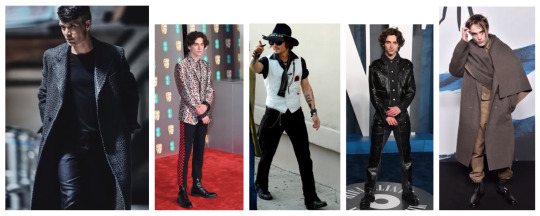
Dramatics look best in sharp, tailored clothes; in bold, extravagant, theatrical styles; …in unconventional or unusual patterns; in asymmetry or straight lines; …in unusual textures or dangerous styles (leather, for example.)
Natural

Yang Dominant (strong features)-- blunt, wide, broad, and elongated…instead of elongated, sharp, harsh (you might see men with Dramatic Essence as the villain in a movie… Natural Essence tends to be… the hero of the film.) Defined by: relaxed, earthy, sporty, active, wild, easygoing, approachable, rugged (...chopping a tree down or hacking a block of wood ready for a fire.)
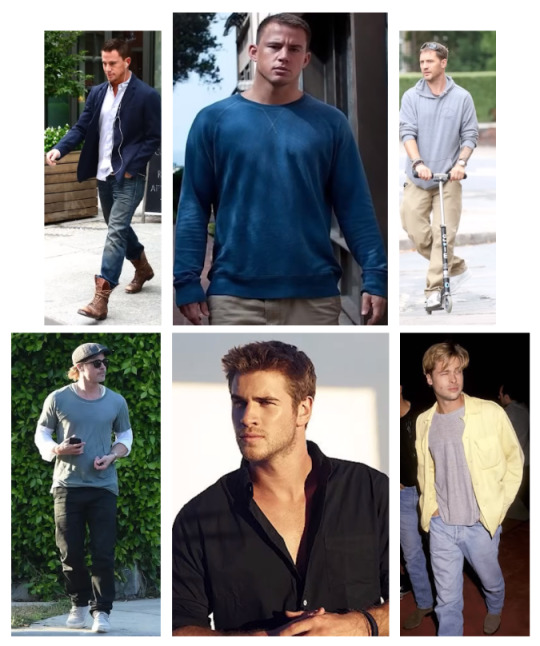
They look best in simple, comfortable, relaxed clothes. They tend to look formal in the most casual and simple styles; whereas… in a suit, they tend to look quite constrained…. Jeans and a t-shirt… don’t look casual or sloppy… looks like it belongs…. Look good in loose fitting; sturdy, oversized sort of styles. Anything with unstructured shapes, layering, or denim.
Gamine

Yang Dominant (strong features)-- sharp or angular features, with some youthful elements (large and soft eyes, or slightly wide and soft noses, or slightly rounded cheekbones with a sharp jaw and narrow eyes.) Defined by: quirky, rebellious, whimsical, youthful (but not as youthful as Ingenue Essence), boyish, playful, fun. Like a Dramatic in some ways… with a youthful undercurrent to them.
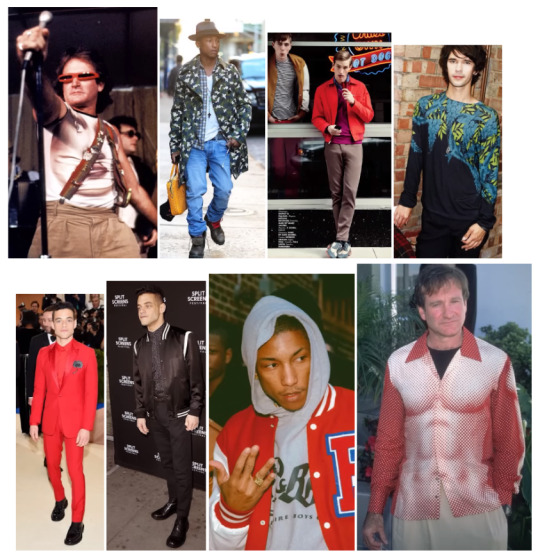
They look really good when poking fun at fashion. They look good in mix-n-match or retro styles. They look good in bold colors or unusual patterns. High contrast; quite cool in rolled up jeans or “teenager” hoodies. They look good in lots of detail and compact styles and maybe some whimsical elements.
Classic

Neither Yang nor Yin Dominant (symmetrically balanced features)-- in the middle, not particularly sharp or soft; timeless, neutral features (no defining characteristic features.) Defined by: clean, timeless, elegant, sophisticated, formal, conservative.
They look best in minimal details, allowing their own beauty to shine through. They look good in smooth and controlled lines. They become more memorable as everything else is "stripped" away. They look good in timeless looks-- it doesn't look boring or outdated; tends to look very elegant and chic. You could even describe them as looking regal... in these styles. They look good in symmetry, balance, neutral colors, and quality fabrics.
Romantic

Yin Dominant (soft features)-- soft, round facial features; smouldering eyes; lush lips; slightly narrow jaws; round cheeks or slightly wide noses; often have dark hair and high contrast (like Dramatics, except with shorter, softer lines.) Defined by: sensual, alluring, lush, romantic.
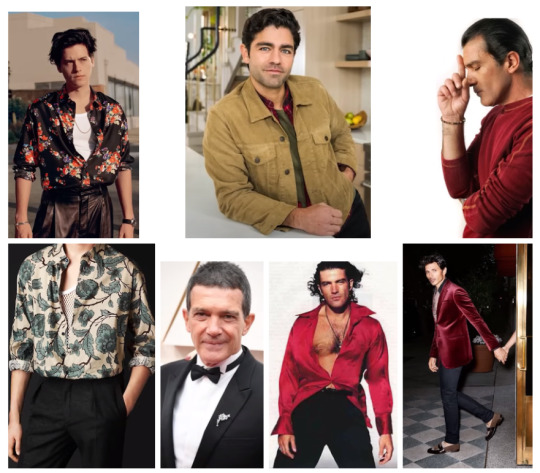
They look good in soft, lush fabrics (like velvet.) Look best in bowties over long ties. They might look good in something a little undone, looser fabrics, softer fabrics. In red or lush colors. In large, rounded patterns. Jewels or jewel tones.
Ingenue

Yin Dominant (soft features)-- baby-like faces (lots of Hollywood male heartthrobs are Ingenues, ex. Leo DiCaprio); small, slightly wide noses; rounder eyes; round cheekbones; plump but smallish lips; rounded and shorter faces. Defined by: sweet looking, innocent, gentle, delicate, adorable, youthful (less “boudoir” than Romantics in the same styles.)
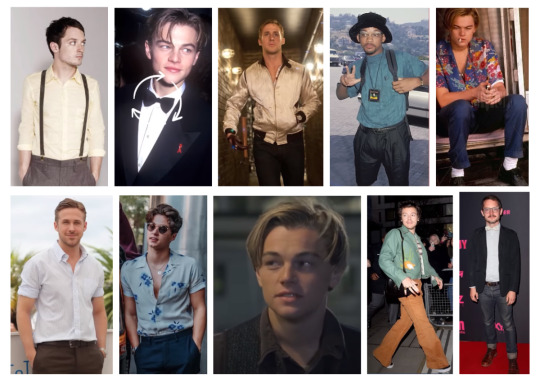
They look best in delicate and small details. Whimsical styles; in anything vintage; in pastel or pale colors; in decorative styles like small floral prints or things that hark back to another era. They look really good in ornate, intricate sort of things. And of course, with soft, delicate fabrics. These men look much better in a bow tie than in a long tie because this mimics their short, rounded facial features.
Ethereal

The Most Yin Dominant (soft features)-- a meeting between yin and yang features. They have elongated faces; some sharp facial features like cheekbones or high foreheads, but with rounded or slightly wide set eyes or soft lips. (Not blending their yin and yang together like Classic, or contrasting it like Gamines.) Defined by: pure, wise, timeless, otherworldly, ageless, old souls, uncanny, celestial (tend to be cast in fantasy roles.)
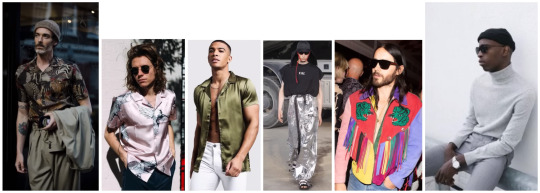
They look really good in metallics; soft, lightweight, fluttery fabrics; vintage or period pieces with… fantastical, ornate, intricate elements. Too many overdone details tips into caricature; instead, they could opt for gray instead of black, or create a long visual line down with their hair.
DAVID DUCHOVNY
Let's start from the top: discovering what are David's worst essences.
What David Isn't
Dramatic
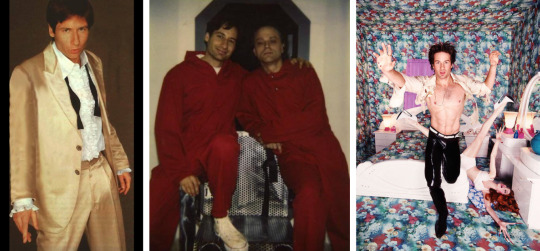
Dramatic is the worst Essence for DD, turning his flare for the "out there" into costume and caricature, wearing him instead of the other way 'round. As such, he often hams up his poses or expressions to better match the energy of the shot, transforming it from avant-garde fashion to tongue-in-cheek performance art.
Gamine

David is drawn to pizzazz, to bold colors, to unique styles. There's a part of his nature that responds to it-- which is easy to see why, when we explore his primary Essence. However: he walks right by the most flattering option to snatch up the second worst.
He's a handsome man, no doubt... but even his looks can't save him from the consequences of his dilapidated fashion sense. Youthful vibes very well with David; but he jumps upon an "aha!" too vigorously, overdoing it with more and more funky, punky, spiky, mismatchy elements. Not even his Kibbe can save him: if he'd been Romantic or Gamine instead of Soft Natural, his shorter bones might have been able to more effectively cover up the disjointed effect.
The bottom rows can be salvageable, as his hairstyle would be dependent on what outfit he wore with it. But even at face value, there's something off about too much tousle either way. The bland-for-him Classic Essence shirt in the last picture doesn't help matters.
Classic

Classic is not the worst on David; but it's not the best, either.
Minimal detail on David tends to wash out his unique charm, burying it under too much finish or polish. The suit in the first picture appears to have been purposefully bought a size up in an attempt to "soften" the silhouette on DD (without success); and the second is too pinched and narrow in the shoulders and too widening and tailored at the hips (a typical Classic silhouette composed of equal parts yin and yang.) The two gray shirts, however, are better: they fit the lines of his body (Kibbe), are Medium Value gray (an aspect of his seasonal color analysis), and are better accessorized with tiny details (buttons and pockets.) Steps in the right direction, but not a complete victory.
Romantic
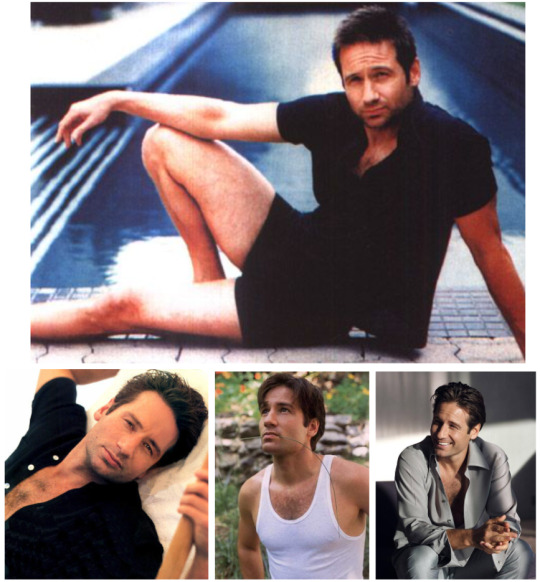
David's styling and poses are overtly sexual here; but the result is more akin to off-the-clock lounging than reach-into-your-heart-through-your-eyes-and-consume-your-soul sensuality. Put more concisely, his sexy isn't boudoir or bodice ripper.
The top pose is the most off-kilter; but the second row's pictures are all salvageable. David's neutral expression in the first pic changes the effect into steamy relaxation; his pose and delicate elements in the second turns the shot into something fresh and almost soulful; and his luxuriously soft hair and pajamas in the third reads as one clean, complete look. The last two particularly are mixed with his primary and secondary Essences.
What David Is
Natural

Maybe. Not discounting the possibility.
It wouldn't be a surprise: David is a Kibbe Soft Natural; and there is definite overlap between its lines and Kitchener's Essence. However: David can only handle teeny tiny amounts of it. Too much and he looks like a clean-shaven homeless man wearing the wealthy neighborhood's overpriced hand-me-downs instead of his old, gunky, raggedy hoodie. That, or a struggling artist.
The top left look is salvageable: his glasses are a complimentarily small detail, his sleeves are rolled up above the wrists, his hair isn't too wild or unkempt, and his pants aren't visible in the shot. Not the best, but definitely not the worst.
Ethereal
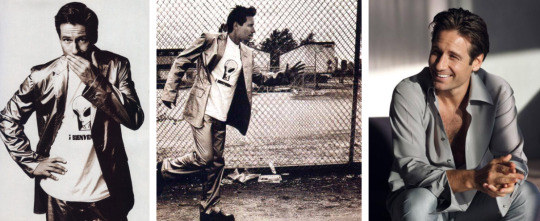
The gray shirt's back! That's because, despite the intent of the shot, the end result is an Ethereal Essence come to life: long, luxurious, draping silhouette; lower contrast grey instead of a harsher, richer color like black; and shadowy, "otherworldly" set dressing.
David's first two looks are from the same photoshoot. The metallic sheen in his suit and Ethereal graphic on his shirt turn this look from a classic silhouette into a statement piece, one that perfectly accords with David's blink-and-you'll-miss-it expression and understated-overstated drama.
However: it's not his best Essence: lines that are too flowy or too long or too "flyaway" jar slightly with his persona-- not quite messy, but not quite right.
Ingenue
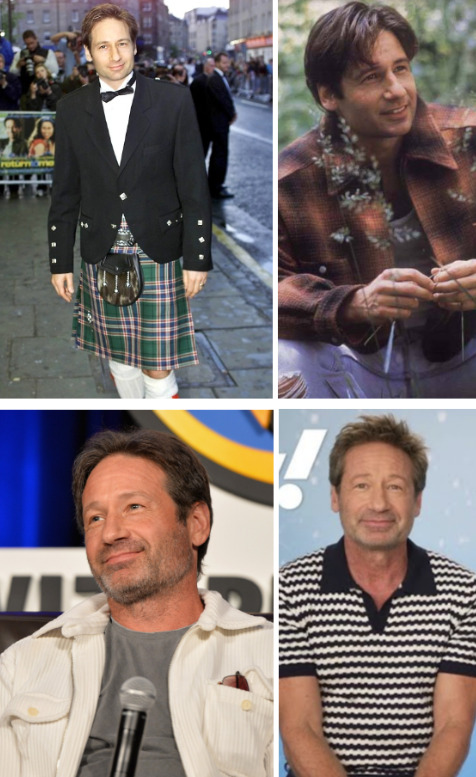
David's best Essence is Ingenue-- and no wonder. Even early on his career, fans were calling him a puppy and wanting to take care of him.
His sensuality is expressed by irrepressible innocence, that element of childishness he misinterprets as Gamine's boyishly spunky, eternally youthful spark. With that in mind, he should focus on softer details instead-- not replacing his funky inclinations so much as tempering them. Funk on a smaller, scale: delicate ornateness instead of jagged edges and opposing prints; repeatable patterns instead of differing styles mashed together. David should also lean into buttons, comfy textured fabrics, and bowties to match the tiny, repeated curves in his face.
COMPARING OTHER SOFT NATURAL ESSENCES
Let's test out his Ingenue Essence.
How shall we do that? By comparing him to other men that share his same Kibbe Soft Natural body type.
Dramatic Essence: None
I don't have a Dramatic SN to compare; but i think we can all conclude that this Essence doesn't scream 'David Duchovny.'
Natural Essence: Brad Pitt and Robert Redford
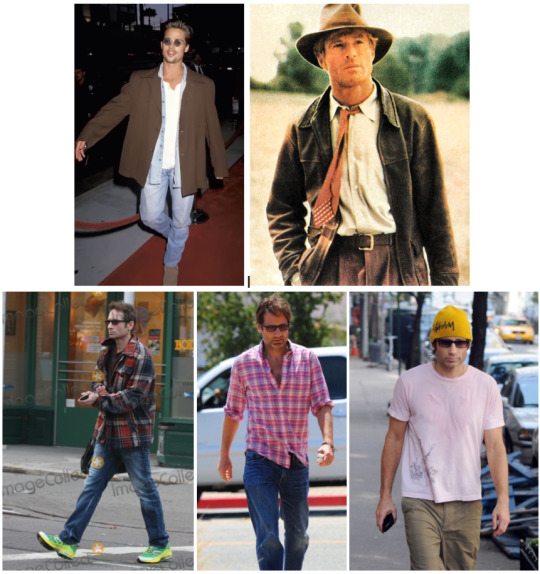
Brad and Robert are put together and at ease in differing levels of "dishevelment." David, though more "himself", does not (even with the same level of tailoring and styling care in the first photo as Brad.)
Gamine Essence: Gene Kelly

Gene comes alive in bold, expressive, potentially clashing elements. David, however, looks mismatched and uncomfortable.
Classic Essence: John Wayne

While John shines with minimal detail, David becomes flat.
Romantic Essence: George Clooney
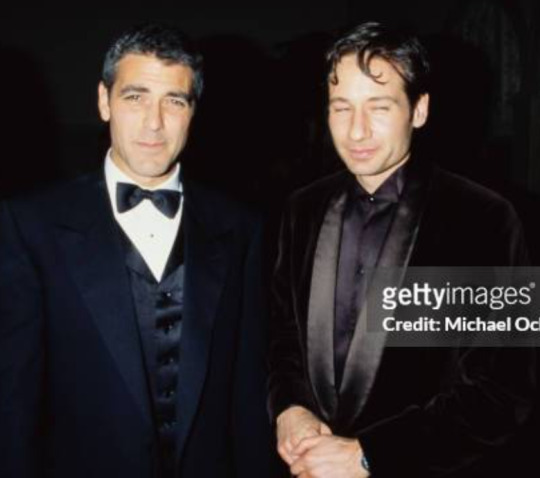
Here we can see George's effortless romanticism and David's endearing Ingenue charm radiating from their pores.
Ingenue Essence: Bing Crosby

With both of their hair slicked up and back, it's too easy to spot the shared tiny, delicate aspects dominating Bing's and David's face. Bing's bowtie and David's small-scale tie further accentuate these features, as do their softer profiles and lower contrast.
Ethereal Essence: None
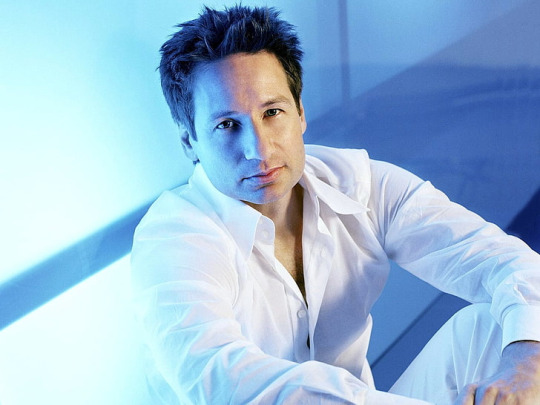
Again, I was unable to find a Kibbe approved Soft Natural that fit the Ethereal requirements. However, I did find DD in an Ethereal shirt and studio set; so, let us gaze upon it, note it works but not fully, and move along.
COMPARING TWO INGENUE ESSENCES

To further prove the Ingenue theory, we can compare him against Kibbe Romantic Elijah Wood's Ingenue Essence. Both have smaller scale facial features, softer lines, and softer silhouettes. They are also complimented very naturally by smaller scale accessories, smaller scale repeating patterns, smaller scale soft tailoring, and smaller scale bowties (compared to their regular ones.) These touches tap into and bring out their "cute" undercurrent easily and effectively.
ALL TOGETHER
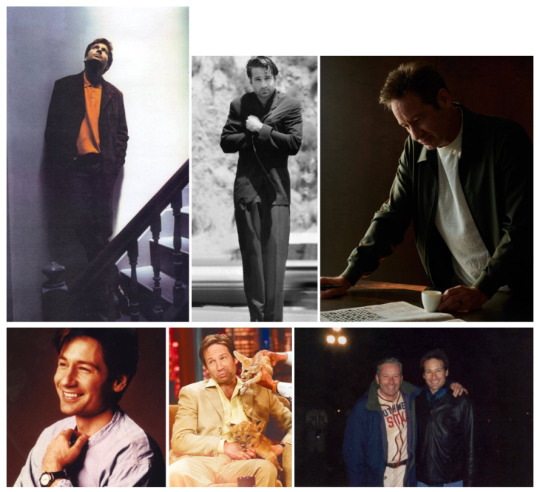
CONCLUSION
Ingenue-Ethereal, perhaps Ingenue-Ethereal-Natural. Not bad!
It makes sense why he and Gillian sold The X-Files: the softened bluntness of his Kibbe created a striking visual contrast against her narrow, sharp Kibbe while their close percentages of Ethereal Essence knit those differences back together in an otherworldly, mythical pursuit of the truth (be it men, monsters, or insane work hours.)
Meanwhile, David is drawn to characteristic detail, unfortunately expressing that dynamic essence through Gamine rather than its perfect twin Ingenue. Furthermore, his love of long, less-restrictive lines is also misplaced in the Natural Essence, whereas it would be right at home in the equally less restrictive but also softer and sleeker Ethereal Essence.
Thanks for reading~
Enjoy!
41 notes
·
View notes
Note
Hey! I’m starting my education in the paralegal field this fall, any tips or advice? Your blog is gorgeous! Hope you’re having a good day :)
Hi! Thank you! I do have a few tips I often like to give:
1) Be a self motivated learner! Alot of the law is researching and learning on the way. You will not know every statute or every filing software. You just google and learn along the way.
2) Legal writing is very different from normal writing, even different from academic writing. Legal writing is very cut, dry, and to the point. It usually follows the IRAC format. Issue, Ruling, Analysis, Conclusion. Basically, state the relevant laws and explain the case.
3) Keep a notebook solely for paralegal tasks! I have a leather diary designated for this. I write down all the little things I learn, like steps for filing motions, steps for serving discovery, jot down important deadlines, jot down legal jargon and commonly used statutes, jot down examples of legal citations to refer to, etc. This really comes in handy!
4) Understand your attorney! Eventually, when you do work with an attorney, identify the type of personality and the type of work environment you like. Some people have a bad experience as a paralegal because they're paired to an insufferable attorney. Some people have a great time, because their attorney is chill, collaborative, and a good mentor. Understand how your attorney likes to do things. How they like to organize tasks, organize files, maintain correspondence, etc. Basically, take their work style, improve on it, and make it more efficient.
5) Network! Alot of times lawyers and law firms are not posting jobs on the internet. It's more word of mouth. So try to network and do legal internships to get your foot in the door.
6) Portfolio! I have a digital and physical portfolio of my work with sample legal documents I drafted, sample case briefs, sample indictments, etc. In today's impossible job market, a portfolio can really help you stand out!
Finally, just have an open mind. When you are in your paralegal classes, it can take a second to get a hang of things. You may also find some patches to be dull and boring. But, the law is very diverse and there are many niches you can go into after graduation. If in the future you want to pivot away from being a paralegal, your experience in law firms or legal offices, can help you enter other fields like business, public policy, etc. A paralegal certificate is truly what you make of it. I kind of see it as a DIY degree!
Hope this helps! Good luck!

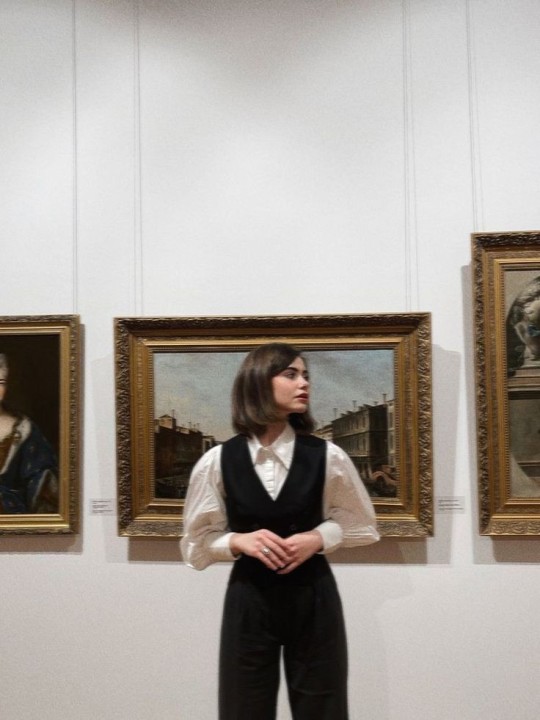
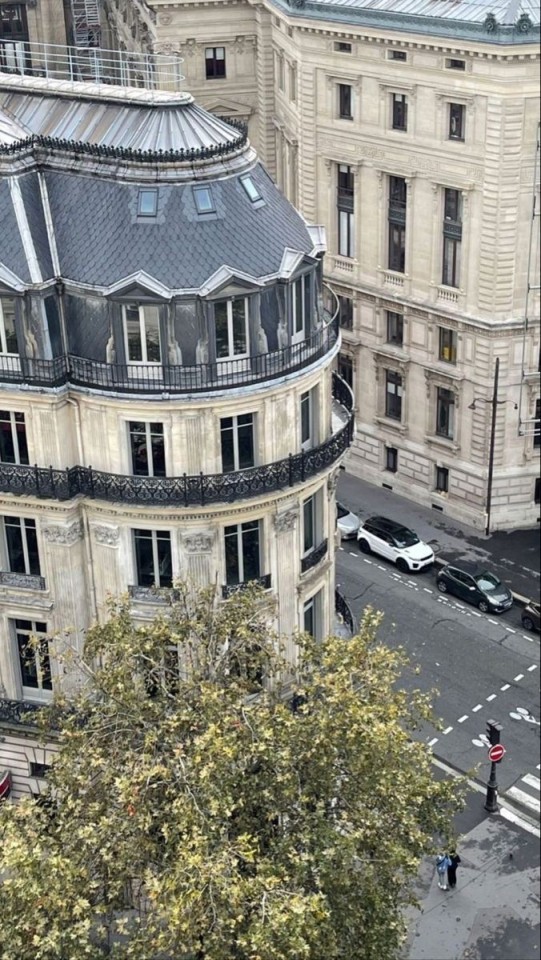
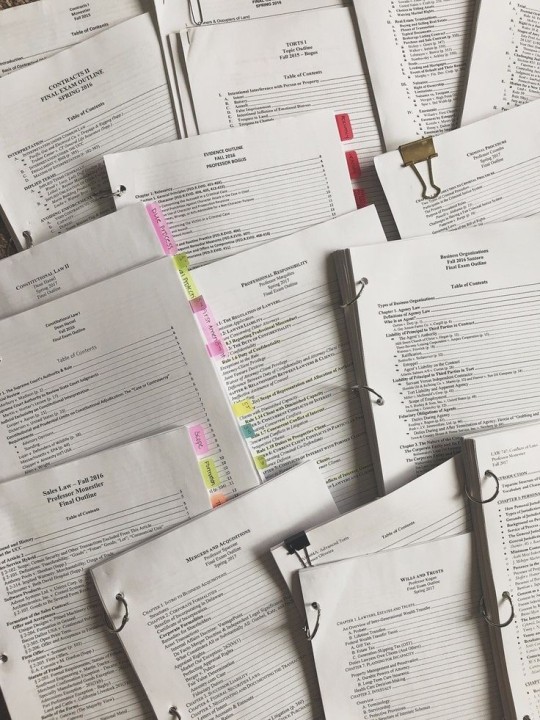
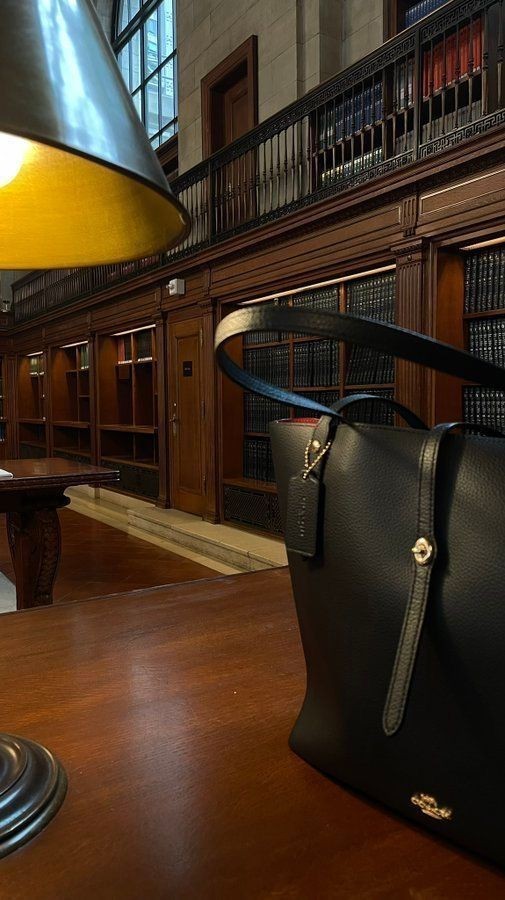



#law studyblr#legally blonde#paralegal#law student#law school#law and order svu#self improvement#student#studyblr#study blog#productivity#it girl#light academia#dark academia
18 notes
·
View notes
Text
In the summer of 1941, the United States sought to leverage its economic dominance over Japan by imposing a full oil embargo on its increasingly threatening rival. The idea was to use overwhelming economic might to avoid a shooting war; in the end, of course, U.S. economic sanctions backed Tokyo into a corner whose only apparent escape was the attack on Pearl Harbor. Boomerangs aren’t the only weapons that can rebound.
Stephanie Baker, a veteran Bloomberg reporter who has spent decades covering Russia, has written a masterful account of recent U.S. and Western efforts to leverage their financial and technological dominance to bend a revanchist Russia to their will. It has not gone entirely to plan. Two and a half years into Russian President Vladimir Putin’s war in Ukraine, Russia’s energy revenues are still humming along, feeding a war machine that finds access to high-tech war materiel, including from the United States. Efforts to pry Putin’s oligarchs away from him have driven them closer. Moscow has faced plenty of setbacks, most recently by losing control of a chunk of its own territory near Kursk, but devastating sanctions have not been one of them.
Punishing Putin: Inside the Global Economic War to Bring Down Russia is first and foremost a flat-out rollicking read, the kind of book you press on friends and family with proselytizing zeal. Baker draws on decades of experience and shoe-leather reporting to craft the best account of the Western sanctions campaign yet. Her book is chock-full of larger-than-life characters, sanctioned superyachts, dodgy Cypriot enablers, shadow fleets, and pre-dawn raids.
More than a good tale, it is a clinical analysis of the very tricky balancing acts that lie behind deploying what has become Washington’s go-to weapon. The risky decision just after the invasion to freeze over $300 billion in central bank holdings and cut off the Russian banking system hurt Moscow, sure. But even Deputy National Security Advisor Daleep Singh, one of the architects of the Biden administration’s response, told National Security Advisor Jake Sullivan that he feared the sanctions’ “catastrophic success” could blow up global financial markets. And that was before the West decided to take aim at Russia’s massive oil and gas exports, which it did with a series of half-hearted measures beginning later that year.
The bigger reason to cherish Punishing Putin is that it offers a glimpse into the world to come as great-power competition resurges with a vengeance. The U.S. rivalry with China plays out, for now, in fights over duties, semiconductors, and antimony. As Singh tells Baker, “We don’t want that conflict to play out through military channels, so it’s more likely to play out through the weaponization of economic tools—sanctions, export controls, tariffs, price caps, investment restrictions.”
The weaponization of economic tools, as Baker writes, may have started more than a millennium ago when another economic empire was faced with problematic upstarts. In 432 B.C., Athens, the Greek power and trading state supreme, levied a strict trade embargo on the city-state of Megara, an ally of Sparta—a move that, according to some scholars, sparked the Peloponnesian War. (Athens couldn’t break the habit: Not long after, it again bigfooted a neighbor, telling Melos that the “strong do what they can, and the weak suffer what they must.”) The irony of course is that Athens, the naval superpower, eventually lost the war to its main rival thanks to a maritime embargo.
It can be tempting to leverage economic tools, but it is difficult to turn them into a precision weapon, or even avoid them becoming counterproductive. The British empire’s 19th-century naval stranglehold and love of blockades helped bring down Napoleon but started a small war with the United States in the process.
Britain was never shy about using its naval and financial might to throw its weight around, but even the pound sterling never acquired the centrality that the U.S. dollar has today in a much bigger, much more integrated system of global trade and finance. That “exorbitant privilege,” in the words of French statesman Giscard D’Estaing, enabled the post-World War II United States to take both charitable (the Marshall Plan, for starters) and punitive economic statecraft to new heights.
The embargoes on Communist Cuba or revolutionary Iran were just opening acts, it turned out, for a turbocharged U.S. approach to leveraging its financial hegemony that finally flourished with the so-called war on terror and rogue states, a story well-told in books such as Juan Zarate’s Treasury Goes to War or Richard Nephew’s The Art of Sanctions.
Osama bin Laden is dead, Kabul is lost, Cuba’s still communist, and a Kim still runs North Korea, but the love of sanctions has never waned in Washington. If anything, given an aversion to casualties and a perennial quest for low-cost ways to impose its will, Washington has grown even fonder of using economic sticks with abandon. The use of sanctions rose under President Barack Obama, and again under Donald Trump; the Biden administration has not only orchestrated the unprecedented suite of sanctions on Putin’s Russia, but also taken Trump’s trade war with China even further.
Despite U.S. sanctions’ mixed record, the almighty dollar can certainly strike fear in countries that are forced to toe a punitive line they might otherwise try to skirt. Banks in third countries—say, a big French lender—could be forced to uphold Washington’s sanctions on Iran regardless of what French policy might dictate. Those so-called secondary sanctions raise hackles at times in places such as Paris and Berlin, prompting periodic calls for “financial sovereignty” from the tyranny of the greenback. But little has changed. Countries that want to continue having functioning banks have little choice but to act as the enforcers of Washington’s will.
What is genuinely surprising, as Baker chronicles, is that the growth of sanctions as the premier tool of U.S. foreign policy has not been matched by a commensurate growth in the corps of people charged with drafting and enforcing them. The Office of Foreign Assets Control, the Treasury Department’s main sanctions arm, is overworked and understaffed. A lesser-known but equally important branch, the Commerce Department’s Bureau of Industry and Security, struggles to vet a vast array of export controls and restrictions with a stagnant staff and stillborn budget. Post-Brexit Britain has faced even steeper challenges in leaping onto the Western sanctions bandwagon, having to recreate in the past few years a new body almost from scratch to enforce novel economic punishments.
Punishing Putin is not, despite the book’s subtitle, about an effort to “bring down” Russia. The sanctions—ranging from individual travel and financial bans on Kremlin oligarchs to asset forfeiture to sweeping measures intended to kneecap the ruble and drain Moscow’s coffers—are ultimately meant to weaken Putin’s ability to continue terrorizing his neighbor. In that sense, they are not working.
One of the strengths of Punishing Putin is Baker’s seeming ability to have spoken with nearly everybody important on those economic frontlines. She details the spadework that took place in Washington, London, and Brussels even before Russian tanks and missiles flew across Ukraine’s borders in February 2022, and especially in the fraught days and weeks afterward. It takes a special gift to make technocrats into action heroes.
The bulk of Baker’s wonderful book centers on the fight to sanction and undermine the oligarchs loyal to Putin who have helped prop up his kleptocracy. Perhaps, as Baker suggests, Western thinking was that whacking the oligarchs would lead to a palace coup against Putin. There was a coup, but not from the oligarchs—and it ended first with a whimper and then a mid-air bang.
There are a couple of problems with that approach, as Baker lays out in entertaining chronicles of hunts for superyachts and Jersey Island holding companies. First, it’s tricky to actually seize much of the ill-gotten billions in oligarch hands; the U.S. government is spending millions of dollars on upkeep for frozen superyachts, for example, but can’t yet turn them into money for Ukraine. And second, the offensive has not split the oligarchs from Putin: To the contrary, a Kremlin source tells Baker, “his power is much stronger because now they’re in his hands.”
At any rate, while the hunt for $60 billion or so in gaudy loot is fun to read about, the real sanctions fight is over Russia’s frozen central bank reserves—two-thirds of which are in the European Union—and the ongoing efforts to strangle its energy revenues without killing the global economy. Baker is outstanding on these big issues, whether that’s with a Present at the Creation-esque story of the fight over Russia’s reserves and the ensuing battle to seize them, or an explanation of the fiendishly complicated details of the “oil price cap” that hasn’t managed to cap Russian oil revenues much at all. More on those bigger fights would have made a remarkable book a downright stunner.
The Western sanctions on Russia, as sweeping and unprecedented as they are, have not ended Putin’s ability to prosecute the war. They have made life more difficult for ordinary Russians and brought down Russia’s energy export revenues, but they have not yet severed the sinews of war. “But, in fact, the West didn’t hit Russia with the kitchen sink,” Baker writes. Greater enforcement of sanctions, especially on energy, will be crucial to ratchet up the pressure and start to actually punish Putin, she argues. The one thing that is unlikely is that the sanctions battle will end anytime soon—not with Putin’s Russia, and not with other revisionist great powers such as China, whose one potential weakness is the asymmetric might of U.S. money.
“As long as Putin is sitting in the Kremlin,” Baker concludes, “the economic war will continue.”
5 notes
·
View notes
Text
2024 anti dumping measure against North Macedonia

Introduction
A recent decision on 2024 anti dumping measure against North Macedonia has been taken by the Ministry of Trade. That measure may have a direct impact upon leading companies originating from North Macedonia.
What does “dumping” mean in trade?
Regarding a end-to-end analysis of export customs regime, see our articles on
Customs Clearances in Turkey
Export Customs Regime in Turkey
What does dumping mean in foreign trade?
International authorities provide a milestone in identifying a global definition of dumping. It is particularly significant to understand that according to the World Trade Organization, dumping is the sale or import of a particular product at less than fair value. Technically, this comparison will be made between the export price of a goods and the “normal value” of the equivalent goods in the exporting country. If the export price is lower than the local market price, that product can be considered “dumped”.
With regard to the useful observations about import customs regime of Turkey take a look at our article on Import Customs Regime in Turkey
Which legal conditions are necessary for initiation anti dumping measure?
After investigating, if the below-mentioned conditions are found, serious measures may be taken by national authorities particularly Ministry of Trade:
The importation of the relevant product must be a typical example of dumping,
Dumping should cause material damage / or threat of harm on domestic production,
Causal link is necessary between this damage or threat and dumped imports.
Therefore, anti-dumping implies actions and practices implemented by relevant domestic authorities to prevent dumping. Anti-dumping investigations may be carried out by the competent Turkish authorities with the intention of the protection of local manufacturers.
For our work and all legal services on the matter of anti-dumping, please click our “Practice Areas”, titled, Anti Dumping
What are the main legal instruments applicable to anti dumping measure in Turkey?
The Law on the Prevention of Unfair Competition of Imports (No: 3577) is the central to the anti-dumping actions and practice. In the Law in question, dumping is defined as ‘export price of a product to Turkey being less than the normal value for the like product’. The Law identifies the rules and principles as regards the procedures to be applied and measures to be taken for purposes of protecting a domestic industry against injury caused by unfair competition practices in imports namely, dumped or subsidized imports.
The Decision on the Prevention of Unfair Competition of Imports and the Regulation on the Prevention of Unfair Competition of Imports are also available online here.
Anti dumping laws should be carefully analyzed in the case of anti dumping investigations first. You may benefit from our updated article on Anti Dumping Investigations in Turkey.
What is the news on 2024 anti dumping measure against North Macedonia?
In accordance with Article 3, measures shall be taken in cases where dumped or subsidized imports have caused material injury or threatened to cause material damage to the domestic industry.
A new decision on 2024 anti dumping measure against North Macedonia has been launched by the Turkish government. This procedure has been initiated by a Communiqué on the Prevention of Unfair Competition in Imports published in the Official Gazette on January 19, 2024. An anti-dumping measure of 1.9 dollars per kilogram will be applied to the import of some artificial and synthetic fibers and leather imitations originating from Northern Macedonia.
The decision is based on the grounds that companies located in the Republic of North Macedonia could not provide a sufficient justification during the investigation procedure.
Conclusion
In the final analysis, a critical decision on 2024 anti dumping measure against North Macedonia is first focus of this paper. Without benefiting an embracing anti dumping consulting service, it is quite challenging to handle investigation procedures and follow-up anti dumping measures in Turkey. What is really important is that there are specific timelines and deadlines for every single legal step. Submission of defense arguments about anti dumping investigations is very critical. Besides, involved companies have a right to lodge a case before administrative courts against anti dumping measures.
In terms of our work on litigation, see practice areas titled “Dispute Resolution and Litigation”
For more information take a look at our articles
Anti Dumping Investigations in Turkey
Anti Dumping Investigation against Russian-based Import
Anti Dumping Hot Rolled Steel Investigation 2023 against China, India, Japan and Russian Federation
3 notes
·
View notes
Text
-> Marlboro Man ad analysis
This ad, from around the 1970s, showcases one of the Marlboro Cowboys, this one being slightly older than the typical Marlboro Man but still having the stereotypical masculinity and western beauty standard to him. The man is donning a white cowboy hat, a worn leather jacket and gloves, and is lighting up a cigarette in the snowy weather. The ad is mainly constructed by diagonal lines, which are created through the edges of his cowboy hat, his jawline and cigarette as well as the angles on his coat. Due to these lines, the viewers' eyes are naturally guided through the whole image, leading to the signature, which in this case are the two Marlboro cigarette boxes that are located in the right lower corner. Another important placement of a feature in the ad is the product itself – the cigarette – which is placed on the centre horizontal line of the image, with its own leading lines created by the arm placement, coat, hat and background object, as it emphasizes the importance of the product in the viewers' eyes. The slogo – a slogan that has become just as iconic as the logo of a brand – is placed right below the horizontal line and right above the signature as an additional call to action to the viewer.
The ad’s main purpose was to attract any man that wanted a taste of freedom and let them know that it’s really that simple. The men that these ads were directed to had a longing for the “good old days”, which was just an illusion of a solution to a problem they had to face. The people behind the campaigns saw an opening in the market and with a carefully constructed fantasy, they were able to speak to the minds of thousands. It is also important to note that the hyper-masculinization of cigarettes, or specifically Marlboros, came mostly due to the rise of studies showcasing the negative effects smoking may bring, especially to pregnant women. This was especially harmful to sales, as the cigarettes were mostly advertised to women beforehand. However, they found that changing the main demographic from women to men could be beneficial mostly as they could use the message that “only weak men fear death” to further their campaign. With the creation of the Marlboro Man, and his successor – Marlboro Country – the company found an unexplored goldmine, making the association of Marlboros to cowboys almost obvious, forever changing the cigarette market.

2 notes
·
View notes
Text
Is Buying a Tissot First Copy Worth It? Pros & Cons
Tissot and other living-in-rocket-companies nameless brands are every bit tempting even at death price. Less than half of the cost for Tissot watches for first-copies. So, Before we buy a first copy watch, let us consider the pros and cons of owning a first copy watch.
This is why first copy watches are so popular — they offer luxury for a fraction of the cost. Tissot original copies are highly regarded for their quality and attention to detail. We will do this by looking at the pros and cons of being the first buyer of Tissot. That will help us decide if it’s a good idea.
Understanding Tissot First Copy Watches
We explore the world of Tissot watches, a well-known name in luxury timepieces. Founded in 1853, Tissot is known for quality and innovation. The first copy market, with its luxury watch replicas, has seen a big rise. Since they are more affordable than the originals, Tissot first clone watches are highly sought after.
What steps go into making and selling first-copy watches? The materials and craftsmanship of these copies are meant to resemble those of the originals. The first luxury wristwatch submarket caters to those who desire high-end watches but cannot afford genuine Tissot timepieces. Cheap watches are very popular today so, Tissot first copy is amazing, same quality but lower price.
Tissot holds a strong place in the luxury watch world, and its replicas are no different. People want these watches for their luxury and prestige. Luxury watch replicas, like Tissot first copy watches, are getting more popular. They offer a cheaper way to own a luxury watch. By understanding the first copy market and Tissot's role, we see the luxury watch industry's complexity and the appeal of Tissot first copy watches.
Quality Assessment of Replica Timepieces
We look at the quality of replica watches, focusing on materials and craftsmanship. We compare original Tissot watches with their replicas. This helps us understand what to expect from a replica in terms of durability and performance.
Quality of a replica watch is an important factor in their worth. Tissot reproductions often feature materials including leather or stainless steel. However, various quality craftsmanship can affect the quality of the watch.
Craftsmanship is vital in replica watch quality. While a poorly built imitation won't last, a well-crafted one can last for years. We contrast the originals with reproductions of Tissot's craftsmanship. This illustrates the benefits and drawbacks of selecting a replica versus an original.
In summary, replica watch quality depends on materials and craftsmanship. Knowing these factors helps us value replica watches better. It also helps us make smart choices when buying a timepiece.
Price Analysis and Value Proposition
Thinking about buying a Tissot first copy watch? The cost savings are huge. Replicas are much cheaper than real Tissot watches. This makes them a great choice for those who want a luxury watch but don't want to spend a lot.
Replicas offer more than just savings. They let you own a luxury brand watch without the high price. But, it's important to think about the possible downsides, like quality issues and legal problems.
The cost of the real Tissot replica is one of the numerous factors influencing this. In that regard, a watch's materials and quality play a major role. Some leave a lot to be desired, while others are outstanding or even great. The two most important factors to consider when buying a watch are price and quality.
So here are some of the reasons why buying a Tissot first copy watch makes sense. What you value most, your style and your budget — all of it matters. An analysis of cost, price, and value enables you to select a solution that meets your goals and budget.
Legal and Ethical Implications
There are serious moral and legal issues with buying and selling replica watches. In a number of countries, such as the US, making and selling counterfeit watches is illegal. This implies that purchasers who purchase or sell these goods risk fines or perhaps legal action.
There are also ethical concerns. Supporting the replica watch market helps create counterfeit goods. This can hurt the real brand's business and reputation. The replica watch world is also tied to crime and other illegal activities, making it a complex issue.
Knowing the laws regarding fake items (watches in our case) are important to make the right decisions. That's the dirty laundry we need to dig up about buying and selling replica watches. This means considering the effect on the original brand, the economy and society.
In summary, the legal and ethical sides of replica watches are complex. We must carefully consider the pros and cons of buying them. This includes thinking about how they affect the real brand, the economy, and society as a whole.
Performance and Durability Factors
We look at how well replica watches perform and last, focusing on Tissot first copy watches. The movements inside these replicas are key to their accuracy and performance. Some studies show that these watches use movements similar to those in real watches, impacting their performance.
Replica watches can last a long time but need more care than real ones. This extra care can add up in maintenance costs. The materials used also play a big role in how durable a replica watch is. Some materials are more likely to get scratched or damaged.
Replica watches might need more repairs than real ones, but repairs can be cheaper. This is because they're not made with the same quality as authentic watches. Yet, some makers are using better materials and movements. This can make their watches last longer and cost less to maintain.
In conclusion, the performance and durability of replica watches are key when choosing a Tissot first copy watch. Knowing about the movements, materials, and upkeep needs helps buyers make smart choices. This way, they can find a watch that fits their budget and meets their expectations for performance and durability.
Market Impact and Brand Considerations
The replica market has a big impact on luxury brands. For example, Tissot first copy watches can affect luxury brands a lot. Studies show that the replica market can cause luxury brands to lose sales. This is because some people choose cheaper options instead.
Brand loyalty is also at risk. Buying replica watches might make people less likely to buy real luxury watches later. This could hurt a brand's customer base and sales over time. The replica market can also make luxury watches seem less valuable. This makes it hard for brands to keep their prices and profits up.
The replica market is growing fast, with more people buying fake goods online. This is bad news for luxury brands. It can hurt their brand loyalty and make their products seem less special. We need to think about how replica watches affect luxury brands and their customers. This includes the risk of losing sales and damaging the brand's image.
Conclusion: Making an Informed Decision
Looking at the pros and cons of a Tissot first copy watch, we see it's a personal choice. It depends on your budget, what you value, and your priorities. These replicas might be cheaper than real Tissot watches. But, you should think about the ethics, legal issues, and how well they last.
0 notes
Text
0 notes
Text
Luxury Leather Goods Market set to hit $232.9 billion by 2035, as per recent research by DataString Consulting
Higher trends within Luxury Leather Goods applications including personal accessories, handbags & wallets, footwear and upholstery & interior design; and other key wide areas like luxury fashion accessories and executive business accessories are expected to push the market to $232.9 billion by 2035 from $123.7 billion of 2024.
Luxury leather items are commonly used as fashion accessories like handbags and designer belts and shoes to elevate ones look and showcase their status symbol with style and class effectively. These products provide benefits such, as top notch quality craftsmanship that lasts long and a sense of exclusivity that sets them apart in the market. Famous brands dominating this sector include Louis Vuitton, Gucci and Prada. Luxury leather products are commonly used in environments as high end business essentials such as leather notebooks and designer wallets are frequently chosen by professionals for both their practicality and fashion appeal. These items stand out for their elegance and lasting quality while also carrying a sense of prestige for those who own them; known brands like Herms and Montblanc lead the way, in this industry.
Detailed Analysis - https://datastringconsulting.com/industry-analysis/luxury-leather-goods-market-research-report
The luxury leather goods sector is experiencing a change towards sustainable and environmentally friendly options due to growing environmental awareness and considerations, for animal rights leading luxury brands to embrace plant based and lab grown leather materials in their products, which has now become an integral part of their brand stories and marketing efforts aimed at attracting a more conscious and ethically minded customer base.
Industry Leadership and Strategies
The Luxury Leather Goods market within top 3 demand hubs including U.S., China and Italy, is characterized by intense competition, with a number of leading players such as LVMH Mot Hennessy Louis Vuitton, Kering SA, Compagnie Financire Richemont SA, Este Lauder Companies, Luxottica Group SpA, Swatch Group, Ralph Lauren Corporation, Signet Jewelers, Tiffany & Co, Burberry Group Plc, Newell Brands Inc and Coach Inc. Below table summarize the strategies employed by these players within the eco-system.
Leading Providers
Provider Strategies
Louis Vuitton, Gucci
Exclusive designs, premium pricing, strong brand presence
Herms, Chanel
Luxury branding, celebrity endorsements, limited edition collections
Prada, Jimmy Choo
Celebrity partnerships, high fashion alignment, unique materials and manufacturing methods
Poltrona Frau, Edra
Quality craftsmanship, design collaborations, niche market targeting
This market is expected to expand substantially between 2025 and 2030, supported by market drivers such as rising disposable income, shift to e-commerce channels, and emphasis on sustainable fashion.
Regional Analysis
The luxury leather goods market in North America holds a share due to the regions affluent consumers and their strong buying capabilities. The United States stands as a player with renowned brands such, as Michael Kors and Coach commanding significant consumer interest. Competition is fierce. Fueled by innovative products and effective marketing tactics. Market trends are increasingly shaped by manufacturing practices. The online shopping trend is rapidly. Presents a lucrative opportunity for e commerce channels to thrive.
Research Study analyse the global Luxury Leather Goods market in detail and covers industry insights & opportunities at Product Type (Handbags, Wallets, Luggage, Belts, Other Accessories), Age Group (Millennial, Generation Z, Baby Boomers, Generation X) and Customer Lifestyle (Status Seekers, Casual Luxury Shoppers, Collectors, Minimalists) for more than 20 countries.
About DataString Consulting
DataString Consulting assist companies in strategy formulations & roadmap creation including TAM expansion, revenue diversification strategies and venturing into new markets; by offering in depth insights into developing trends and competitor landscapes as well as customer demographics. Our customized & direct strategies, filters industry noises into new opportunities; and reduces the effective connect time between products and its market niche.
DataString Consulting offers complete range of market research and business intelligence solutions for both B2C and B2B markets all under one roof. DataString’s leadership team has more than 30 years of combined experience in Market & business research and strategy advisory across the world. Our Industry experts and data aggregators continuously track & monitor high growth segments within more than 15 industries and 60 sub-industries.
0 notes
Text
MG Hector EV Price in Chennai: The upcoming MG Hector EV adds luxury to eco-friendly driving
As electric vehicles take over the market MG Motor leads by providing eco-friendly vehicle solutions to customers. The anticipated MG Hector EV arrival into the market will push comfortability and environment protection forward. Anyone choosing the premium electric SUV in Chennai should know both the MG Hector EV price and perks to decide correctly.
Why Choose the MG Hector EV?
The MG Hector EV shows how the brand unites the most recent technology with green driving options. Here are some key reasons to choose this electric SUV:
Eco-Friendly Performance: The MG Hector EV's exhaust system makes clean air by not releasing pollution.
Advanced Technology: The vehicle comes with advanced technology including internet-linked systems voice-control and a large display panel.
Luxurious Design: The Hector EV shows its beauty on the outside and offers a sumptuous ride space inside.
Spacious and Practical: It features roomy seating for families plus space to haul items both near and far.
MG Hector EV Price in Chennai
Our research shows the MG Hector EV will cost between ₹25 lakh to ₹30 lakh according to market expectations but the official price has not been disclosed yet. Here are some factors that influence its on-road price in Chennai:
Government Incentives:
Tamil Nadu reduces costs for electric vehicle owners through state support programs.
Insurance Premiums:
Business insurance packages differ in terms of what they cover plus optional feature selections.
Additional Costs:
Purchasing extras with warranty protection plus home charging equipment adds to the vehicle's final price.
There are good reasons to consider buying an MG Hector EV in Chennai.
Chennai is changing to become more EV-friendly, so buying an MG Hector EV makes perfect sense for people in this region. Here are some benefits:
Expanding Charging Infrastructure:
Chennai now offers many places to charge electric cars in public, making recharging easy.
Cost Savings:
The MG Hector EV lets you spend less money on fuel and care when compared to standard internal combustion vehicles.
Government Support:
Being supportive of EVs, Tamil Nadu lets you buy an electric car at lower cost and with simpler rules.
Sustainability:
Driving the Hector EV helps us create a cleaner environment while decreasing air pollution.
The MG Hector EV Features Explained
Electric Powertrain:
The vehicle delivers strong driving capabilities while covering long distances both in urban traffic and on highways.
Connected Technology:
The electric MG Hector features wireless technology updates as well as location guidance and active car analysis.
Safety:
The vehicle uses advanced technology by including multiple airbags together with ABS with EBD plus a full 360-degree camera system.
Premium Interiors:
The cabin includes premium leather seating plus adjustable lights with comfortable space between rows.
Conclusion
People in Chennai searching for a luxurious, affordable electric SUV can trust that the MG Hector EV's pricing makes it just right for them. Through luxury elements advanced engineering and green energy technologies the Hector EV alters how people think about electric vehicles. Head over to the MG showroom in Chennai to navigate through the Hector EV, learn about current pricing, and drive it yourself. Experience eco-friendly driving through the future of mobility by choosing the MG Hector EV.
0 notes
Text
0 notes
Text
Leather Goods Market Forecast Report and Company Analysis 2024-2032, Hermes International, Adidas, Nike, Puma, Fila, VIP Industries, Samsonite, VF, and Lear
Dublin, Dec. 04, 2024 (GLOBE NEWSWIRE) — The “Leather Goods Market Report Forecast by Type, Product, Countries and Company Analysis 2024-2032” report has been added to ResearchAndMarkets.com’s offering. The leather goods market is anticipated to rise from about US$296.26 billion in 2023 to US$453.34 billion by 2032, with a CAGR of roughly 4.84% between 2024 and 2032. This is driven by increasing…
0 notes